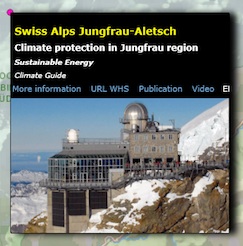Climate protection in Wold Heritage Site
 The Jungfrau region has taken a number of different steps to promote renewable energy. For example, a power station fired by wood chips to be built in Grindelwald is at an advanced planning stage. It will run on locally available wood and is intended to produce district heating for various buildings in the commune.
The Jungfrau region has taken a number of different steps to promote renewable energy. For example, a power station fired by wood chips to be built in Grindelwald is at an advanced planning stage. It will run on locally available wood and is intended to produce district heating for various buildings in the commune.
At the world’s highest solar power station on the Jungfraujoch, research is underway into the behaviour of solar cells at high altitude and in extreme weather conditions. Specialists expect annual power generation to be about 70% higher than that of a comparable facility in the plateau.
Emission-free hydro-electricity has been produced in the Jungfrau region for more than 100 years now. In the beginning, the driving force were local hotel owners, who obtained a concession to build a hydroelectric station in Grindelwald in 1896. The Isch station came into operation in 1897. And the Stechelberg power station has been supplying the commune of Lauterbrunnen and other customers with electricity since 1906. The Birrmättli hydro plant built in the drinking water supply system, has been using water in a different way to generate power since 2005.
Mürren and Wengen are pioneers of another kind in climate protection. The streets of both villages are dominated by the sight of electric vehicles. Even the employees of the power plant in Lauterbrunnen ride Flyer electric bikes when they go off on jobs.
JUNGFRAU CLIMATE GUIDE














